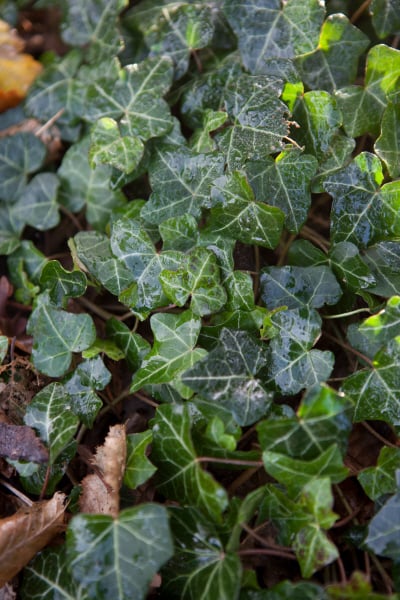Hedera helix
common ivy
A vigorous, self-clinging climber with three- to five-lobed, glossy, evergreen leaves, often with pale green veins, and some reddish or bronzy colours in autumn. Mature plants produce bushy, non-clinging branches with diamond-shaped leaves, and small, nectar-rich, greenish-yellow flowers in clusters of rounded heads in autumn, followed by black berries in winter. An important wildlife plant, providing food, shelter and nest sites for many birds, insects and small mammals
Size
Ultimate height
8–12 metresTime to ultimate height
10–20 yearsUltimate spread
2.5–4 metresGrowing conditions
Moisture
Moist but well–drained, Well–drainedpH
Acid, Alkaline, NeutralColour & scent
| Stem | Flower | Foliage | Fruit | |
| Spring | Green | |||
|---|---|---|---|---|
| Summer | Green | |||
| Autumn | Green | Green | ||
| Winter | Green | Black |
Position
- Full shade
- Full sun
- Partial shade
Aspect
South–facing or North–facing or West–facing or East–facing
Exposure
Exposed or ShelteredDrought resistance
Yes Hardiness
H5Botanical details
- Family
- Araliaceae
- Native to GB / Ireland
- Yes
- Foliage
- Evergreen
- Habit
- Climbing
- Potentially harmful
- Harmful if eaten: skin irritant/allergen. Wear gloves and other protective equipment when handling. Pets (dogs, cats, rabbits, rodents): Harmful if eaten, skin irritant/allergen. For further information and contact numbers regarding pets, see the HTA guide to potentially harmful plants
- Genus
Hedera are evergreen climbing shrubs clinging by aerial roots. Clusters of small yellow-green flowers are followed by usually black berries. Foliage of flowering shoots is often less deeply lobed than that of the sterile, climbing shoots
- Name status
Correct
- Plant range
- Europe, W Asia
How to grow
Cultivation
Tolerant of a range of soils and conditions, ivy grows best in fertile, humus-rich, well-drained, alkaline soil in a sheltered spot; see hedera (ivy) cultivation. As a tough, long-lived plant, with the ability to spread rapidly, it is not always welcome. However it can be tolerated, even encouraged, in many garden situations such as ground cover in deep shade, or masking an ugly fence. See ivy on buildings and fences, and ivy on trees and as groundcover for more information
Propagation
Propagate by semi-hardwood cuttings in summer. Cuttings from adult growth will produce shrubby, non-climbing plants
Suggested planting locations and garden types
- Coastal
- Wildlife gardens
- Low Maintenance
- Banks and slopes
- Ground cover
- Wall side borders
Pruning
Pruning group 11 at any time
Pests
May be susceptible to glasshouse red spider mite, scale insects, vine weevil and aphids
Diseases
May be susceptible to honey fungus (rarely) and a leaf spot
Get involved
The Royal Horticultural Society is the UK’s leading gardening charity. We aim to enrich everyone’s life through plants, and make the UK a greener and more beautiful place.
